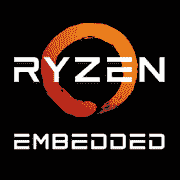AMD Ryzen Embedded R1600

AMD Ryzen Embedded R1600: Compact Power for Niche Tasks
April 2025
Architecture and Process Technology: Zen on 14nm
The AMD Ryzen Embedded R1600 processor is based on the first generation Zen microarchitecture, which by 2025 is already considered outdated. However, for embedded systems and specialized devices, this solution remains relevant.
- Cores and Threads: 2 cores and 4 threads thanks to Simultaneous Multithreading (SMT) technology.
- Clock Speeds: Base frequency of 2.6 GHz, maximum in turbo mode is 3.1 GHz.
- Cache: 4 MB of L3 cache, which provides quick access to frequently used data for a dual-core CPU.
- Process Technology: 14nm FinFET. Compared to modern 5-7nm chips, this appears archaic but reduces manufacturing costs and improves reliability.
- iGPU: None. A discrete graphics card or external solutions are required for graphics.
Architecture Features:
The first generation Zen brought significant IPC (instructions per clock) improvements compared to previous AMD architectures. However, by 2025, its potential is limited: no support for PCIe 4.0 and reduced AI acceleration capabilities.
Power Consumption and TDP: A Balance Between Power and Efficiency
The processor's TDP is 25W. This is higher than that of modern mobile chips (for example, Intel Core i3-N305 with a TDP of 15W) but lower than that of gaming CPUs (45W+).
- Heat Dissipation: A compact cooler is sufficient for heat removal, allowing the R1600 to be used in thin laptops or industrial PCs.
- Energy Efficiency: Among competitors, 25W is not the best indicator. For example, the Apple M2 consumes 10-15W for similar tasks.
Performance: Modest but Practical
Geekbench 6 results (Single-Core: 818, Multi-Core: 1401) place the R1600 alongside budget processors from 2023-2024.
- Office Work: Documents, a browser with 10+ tabs, Zoom — the processor handles these tasks, but running “heavy” applications (like Photoshop) simultaneously may cause slowdowns.
- Multimedia: Streaming video (4K), listening to music, photo editing in Lightroom — no issues. Video rendering in DaVinci Resolve will take 2-3 times longer than on quad-core CPUs.
- Gaming: Only for undemanding projects (Dota 2, Minecraft) on low settings with a discrete GPU like the NVIDIA MX550. The lack of integrated graphics is a critical downside for gaming.
- Turbo Mode: Under load on one core, the frequency can rise to 3.1 GHz, but due to the limited thermal envelope, maintaining peak performance for long isn’t feasible.
Use Cases: Who is the R1600 Designed For?
- Office Laptops: Suitable for employees working with cloud services and office software.
- Industrial PCs: Embedded systems, kiosks, and terminals — the reliability of Zen and support for long life cycles (AMD guarantees supply of these chips until 2030).
- Home Media Centers: Streaming content and smart home management.
- Educational Devices: Affordable laptops for students (for example, models like Acer TravelMate B3).
Not Suitable For:
- Gamers and streamers.
- Professional designers and video engineers.
- Users who require more than 8 hours of battery life.
Battery Life: A Compromise Between Power and Working Time
With a TDP of 25W, a laptop with the R1600 and a 50Wh battery will work for about 4-6 hours in mixed-use mode (web surfing + office).
Power-Saving Technologies:
- AMD SenseMI: Dynamic frequency and voltage management.
- Cool’n’Quiet: Reducing power consumption during idle.
- C-States: Disabling unused cores.
Tip: Choose devices with a battery of at least 60Wh and an IPS screen with low power consumption (for example, LG Display 1080p 300 nits).
Comparison with Competitors
- AMD Ryzen 3 7320U (Zen 2, 4 cores, 15W): 30% higher performance in multi-threaded tasks, lower TDP. Laptops start at $500.
- Intel Core i3-1215U (10nm, 6 cores, 15W): Better multitasking, includes Intel UHD Graphics iGPU. Device prices start at $550.
- Apple M1 (5nm, 8 cores, 10W): 2-3 times higher performance, battery life up to 18 hours. MacBook Air M1 starts at $799 (on sale).
Conclusion: The R1600 lags behind modern counterparts but excels in price (laptops from $400) and reliability for embedded solutions.
Pros and Cons
Strengths:
- Low cost of devices.
- Long-term support (until 2030).
- Sufficient performance for basic tasks.
Weaknesses:
- No integrated graphics.
- Only 2 cores.
- Outdated 14nm process technology.
Laptop Selection Recommendations
- Type of Device: Entry-level ultrabooks (e.g., Lenovo IdeaPad 3), industrial laptops (Panasonic Toughbook CF-33).
- What to Look For:
- Presence of a discrete GPU if graphics are needed.
- RAM capacity — at least 8GB DDR4.
- SSD of 256GB+ (NVMe preferred).
- Ports: USB-C, HDMI for peripheral connections.
Examples of 2025 Models:
- HP ProBook 445 G9: 14" screen, 8GB RAM, 256GB SSD, price — $450.
- Dell Latitude 3540: 15.6", 16GB RAM, AMD Radeon 610M, price — $600.
Final Verdict
The AMD Ryzen Embedded R1600 is a specialized solution for:
- The corporate sector, where reliable and durable devices are needed.
- Educational institutions with limited budgets.
- Industrial systems where stability, rather than peak performance, is essential.
Key Benefits:
- Optimal price-to-performance ratio for basic tasks.
- Long service life and support.
- Compatibility with modern operating systems and software.
If you need a laptop for document work, surfing, and straightforward multimedia tasks, the R1600 would be a worthwhile choice. However, for gaming, creative work, or running "heavy" applications, it's better to look at more modern CPUs.
Basic
CPU Specifications
Memory Specifications
GPU Specifications
Benchmarks
Compared to Other CPU
Share in social media
Or Link To Us
<a href="https://cputronic.com/en/cpu/amd-ryzen-embedded-r1600" target="_blank">AMD Ryzen Embedded R1600</a>